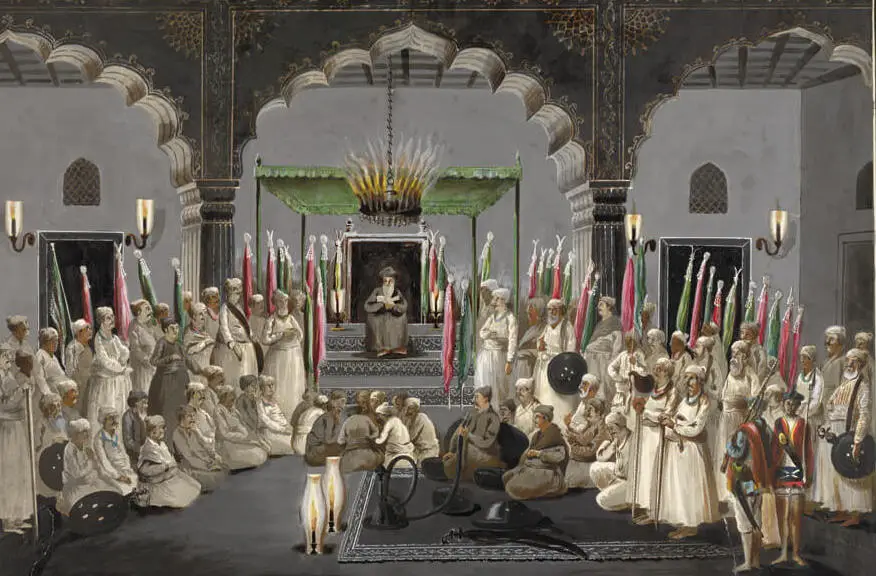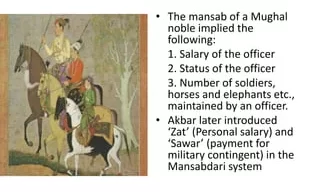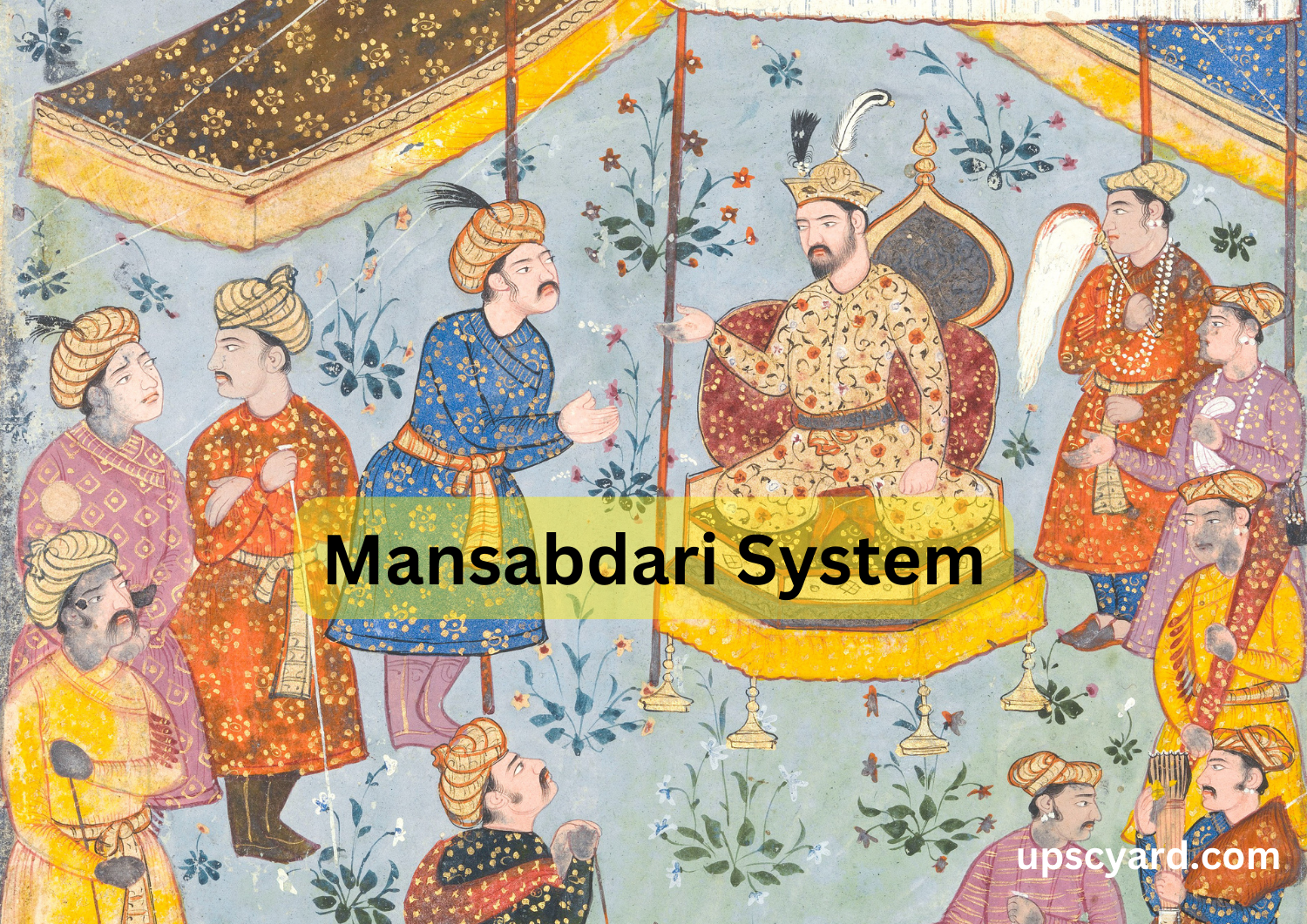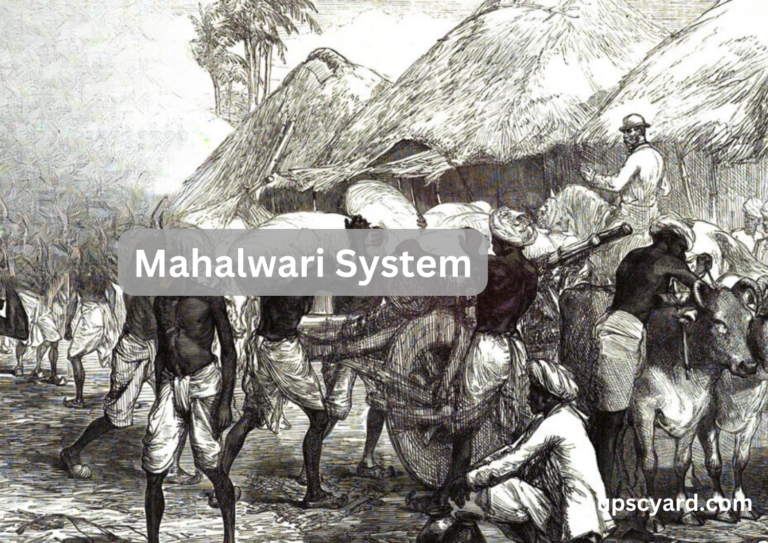Unveiling the Mansabdari System

Understanding the Mansab System
The term “mansab” in the Mughal era denotes a position and rank within their administrative structure. During Babur’s time, the term “wajhdar” was initially used instead of “mansabdar.” However, this shifted with the evolution of the Mansab system under the Mughals.

Akbar’s Role in Mansab Allocation
Akbar, the visionary Mughal emperor, allocated mansabs to both military and civil officers based on merit or service to the state. Inspired by Chingiz Khan’s principles, Akbar structured his army on a decimal system. The Mansab system, as established by Akbar, featured 66 grades, ranging from commanders of 10 horsemen to 10,000 horsemen, although Abul Fazl mentions only 33 grades.
Significance of Mansab
Mansab held a triple significance:
- Status Determination:
- It placed the mansabdar in the official hierarchy, defining their status.
- Pay Fixation:
- It determined the pay of the mansabdar according to a specific schedule.
- Obligation Imposition:
- It mandated the maintenance of a specified contingent with horses and equipment.
The Dual Ranks: Zat and Sawar
A significant shift occurred around 1595-96 when mansabdars’ ranks came to be denoted by two numbers – zat and sawar. The zat determined personal pay and rank, while the sawar fixed the number of horses and horsemen to be maintained by the mansabdar.
There was a classification in 1595-96 based on the relationship between zat and sawar, grouping mansabdars into three categories:
- Those with sawar equal to the zat.
- Those with sawar half or more than half of the zat.
- Those with sawar rank less than half of their zat.
Exceptional Cases and Reforms
Exceptions existed, especially during difficult circumstances. Reforms included conditional rank (mashrut) for temporary increases in sawar rank. Another innovation, “do aspa sih aspa,” allowed a part or full sawar rank to be doubled, serving specific military needs.
The Three Classes of Mansabdars
In 1595-96, a classification emerged based on the relationship between zat and sawar. Mansabdars fell into three groups:
- Those with sawar equal to the zat.
- Those with sawar half or more than half of the zat.
- Those with sawar rank less than half of their zat.
The dual-rank system provided flexibility, and exceptions were made in challenging terrains.
Appointment and Promotion of Mansabdars
The Mir Bakshi played a key role in presenting candidates for mansabdari to the Emperor. The process involved recommendations from nobles and provincial governors, leading to confirmation by the Emperor through a detailed procedure.
Appointing a mansabdar was solely the Emperor’s prerogative, and there were no written exams. Certain norms were followed, with preferences given to khanazads (sons or close kinsmen of those in service), individuals from other kingdoms, and rulers of autonomous principalities like Rajput kings.
Promotions were influenced by performance, lineage, racial considerations, and unwavering loyalty. The attainment of higher pay and noble titles was contingent on exceptional services or skill in affairs, reflecting the complexity of the Mansab system during the Mughal reign.
Troop Maintenance and Payment in the Mansab System
Inspection and Validation
Maintaining troops in the Mansab system involved regular inspections and physical verification. The mir bakshi’s department conducted these inspections using a special procedure known as “dagh o chehra.” Horses presented for inspection were branded with a specific pattern to distinguish them, and their physical descriptions were recorded to prevent presenting the same horses for inspection. Non-fulfillment of the obligation to maintain specified contingents could result in a reduction in rank.
Obligations Based on Location
Under Shah Jahan’s rule, specific obligations were set based on a mansabdar’s posting location. If posted in the same province as their jagir, one-third of the contingents had to be mustered; if posted outside, one-fourth; and if posted in Balkh and Samarqand, one-fifth.
Salary Structure
The salary scale was fixed for the zat rank, and there was no arithmetical or proportionate relationship between ranks. In other words, the salary did not increase or decrease proportionately with rank changes.
The System of Escheat
Escheat, or the Emperor taking possession of nobles’ wealth after their death, was a common practice. Nobles often had unpaid loans to the state, and the Khan Saman’s duty was to take over their property and adjust state demands. The rest of the property could be distributed among heirs, sometimes at the Emperor’s discretion.
State Control and Adjustments
In 1666, Aurangzeb issued a farman instructing that their property would be deposited in the state treasury after the death of a noble without heirs. Another farman in 1691 instructed state officers not to attach the property of nobles whose heirs were in government service, as they could be asked to pay the mutalaba.
Composition of Mansabdars
Despite the theoretical openness of mansabdari to all, practical considerations favored heredity. Khanzads (descendants of mansabdars) had the first claim, with roughly 476 out of 575 mansabdars holding the rank of 1000 and above during Aurangzeb’s reign being khanzads. Additionally, recruitment included zamindars, Persians, Chagatai, Uzbeks, Deccanis, Turanis, Afghans, Indian Muslims (shaikhzadas), Rajputs, Marathas, and Deccanis, with larger recruitment from the last two groups during Aurangzeb’s reign due to military reasons. The racial composition of the Mansabdars reflected the diverse cultural tapestry of the Mughal Empire.
F.A.Q.
- Q. What is Mansabdari System?
Answer :- Akbar implemented the Mansabdari system in the Mughal Empire in 1571, creating an administrative framework. The term “Mansab” is derived from Arabic, signifying rank or position. Mansabdari involved ranking government officials, delineating their civil and military responsibilities, and specifying their remuneration. This system played a crucial role in organizing and structuring the administrative machinery of the Mughal Empire.
- Q. Who introduced Mansabdari System?
Answer :- Akbar in 1571



